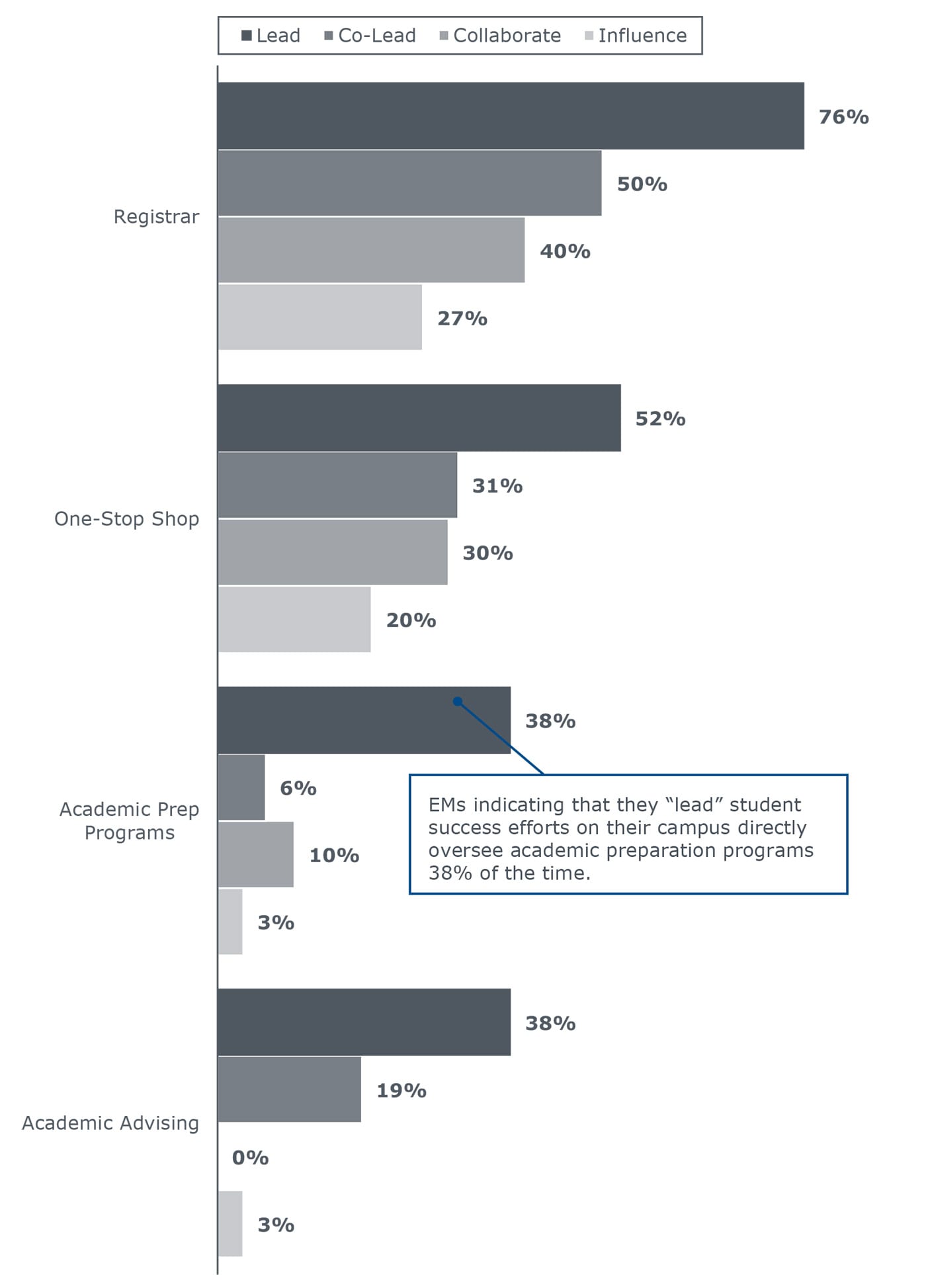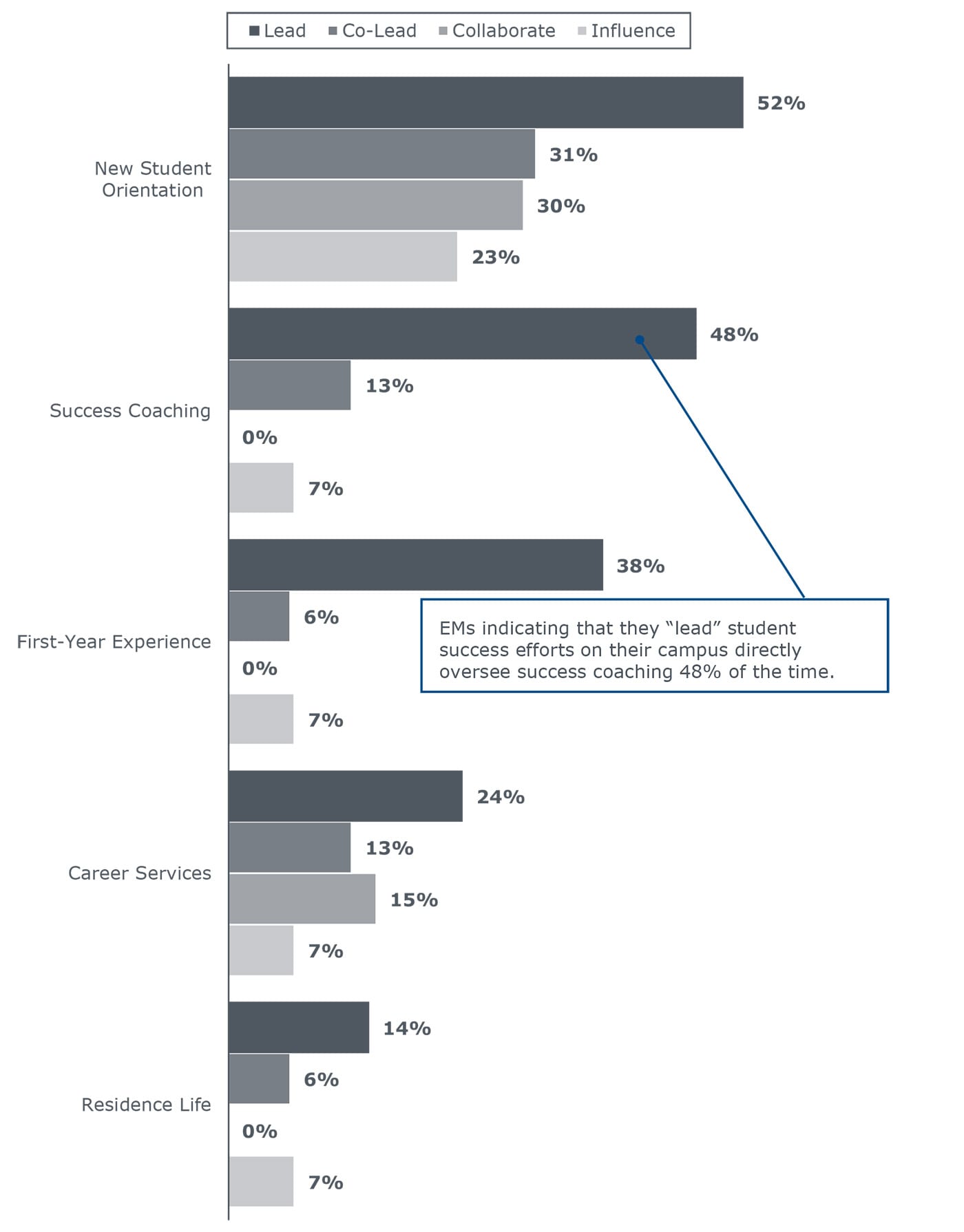As universities seek to improve student outcomes, institutional leaders often look to enrollment managers to help develop and implement an integrated set of student success strategies across the student lifecycle.
As part of our Enrollment Management Benchmarking Survey we asked enrollment managers to identify which of the following roles best characterized their relationship to their institution’s student success mission:
- Lead: Hold primary leadership and formal accountability for student success according to job description or performance review
- Co-Lead: Lead or co-chair a committee or task force on student success
- Collaborate: Sit on but do not lead a student success committee or task force
- Influence: Influence student success through owned EM functions, but not tasked with it formally
As outlined in the graphic, 42% of the respondents either lead or co-lead their institution’s success mission. While EMs with formal leadership roles in success are the minority, survey respondents anticipated increased accountability: 45% of enrollment managers expect their role in student success to expand in the coming year. This number was higher for public institutions (51%) than for private institutions (36%), but EMs at both anticipate growing responsibility for student success.
Percentage of EMs by their Student Success Role (All Schools)

EM roles in success: Public versus private
There are only small differences between enrollment managers at public and private institutions across the spectrum of success roles: EMs at publics are more often leaders of campus student success initiatives and less often influencers.
Percentage of EMs by their Student Success Role

Success leaders oversee a broader portfolio of offices
As admissions and financial aid offices play a larger role in retention and graduation, enrollment managers assume greater responsibility for coordinating campus success initiatives.
Read more about how financial aid can promote student success
Beyond those traditional EM offices, the survey enabled us to examine the link between EM control of offices and the role played in student success.
For EMs who characterized their role in success as either “lead” or “co-lead,” we compared the campus offices they oversee to those EMs with less formal responsibilities for success. We found that the lead and co-lead EMs were more likely to supervise offices that reflect their broader roles in supporting student success efforts. Specifically, the survey revealed more oversight of student academic support and student life units.
Structuring EM around success: Delivering student academic support
The survey found that leadership of student success is strongly correlated with EM supervision of four offices supporting student academics:
- Registrar
- One-stop shop*
- Academic prep programs
- Academic advising
Rate of Direct Supervision of Offices by Role in Student Success (All Schools)

As a lack of academic preparedness is one of the key obstacles to student persistence and completion, greater oversight of student academic support gives EMs more control to guide interventions.
* One-stop shops pertain to both categories but are included here because they typically include the registrar, a key student academic support unit.
Structuring EM around success: Supporting student life
With respect to student life levers, EM leadership of student success is correlated with management of five offices:
- New student orientation
- Success coaching
- First-year experience
- Career services
- Residential life
Rate of Direct Supervision of Offices by Role in Student Success (All Schools)

The prevalence of EM ownership of traditional student affairs functions indicates that accountability for success outcomes requires an ability to invest in and guide interventions across the student lifecycle. We see evidence of this with increased ownership of offices ranging from new student orientation to career services.
Greater responsibility requires appropriate levers
The survey findings provide an empirical view of what EM functions look like when student success is assigned to the senior enrollment manager. Based on this snapshot, members who anticipate more accountability for student success should assess their office portfolio to determine how effectively it supports their ability to achieve the institution’s goals.
On-demand training: Craft a holistic approach to student success on campus
Get more insight on EM organizational structures
Our Enrollment Management Benchmarking Survey asked 88 enrollment managers about their organizational structures, staffing and salaries, budgets, and vendor relationships. The first part of the findings, Enrollment Management Snapshot: Structure, Operations, and Partnerships, focuses on EM organization. Download the report here
